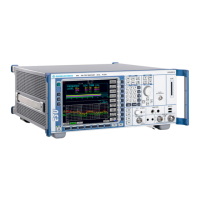R&S ESU Instrument Functions
Receiver Mode
4.52 Operating Manual 1302.6163.12 - 03
Table 4-1 Default setup of scan table
The diagram parameters to be defined are: start frequency 150 kHz, stop frequency
1 GHz, min. level 0 dBµV, grid range log 100 dB, log. frequency axis and continuous
scan.
The measurement parameters correspond to the settings recommended for over-
view measurements to CISPR 16.
4.5.5.2 Time Domain Scan in the Frequency Domain
Up till now, long EMI measurement times were necessary in EMC test laboratories,
when correct measurements of unknown EUTs had to be made. Time saving proce-
dures as explained in “Data Reduction and Peak List” on page 4.33 reduced the
total measurement time by reducing the number of quasipeak measurements to a
minimum. But this time is still very long, because it is often in the order of hours,
especially for the CISPR radiated emission test. A way out of this situation can be
time-domain measurements. Whereas in conventional EMI measurement systems,
only the spectrum within the IF filter can be measured during a certain measurement
time of e.g. 100 ms, in TDEMI measurement systems, large parts of the spectrum at
the receiver input can be measured during the same time and it depends on the
dynamic range and the resolution of the A/D conversion system, how accurate the
measurement results are. Systems with higher resolution can provide a higher
dynamic range.
The R&S ESU uses an internal fast A/D converter with up to 80 MHz sampling rate
to convert a spectrum width of up to 7 MHz at a time. The restriction of the FFT width
is due to the built-in preselection.
Range 1 Range 2
Start frequency 150 kHz 30 MHz
Stop frequency 30 MHz 1 GHz
Step width Auto Auto
IF bandwidth 9 kHz 120 kHz
Measurement time 1 ms 100 µs
Auto ranging OFF OFF
Attenuation mode Normal Normal
RF attenuation 10 dB 10 dB
Preamplification OFF OFF
This functionality is only available with the R&S ESU-K53 option.
Frequency range Max. Resolution
Bandwidth
FFT width
<= 150 kHz 50 kHz 150 kHz
150 kHz … 2 MHz 50 kHz 2 MHz
2 MHz … 8 MHz 50 kHz 500 kHz

